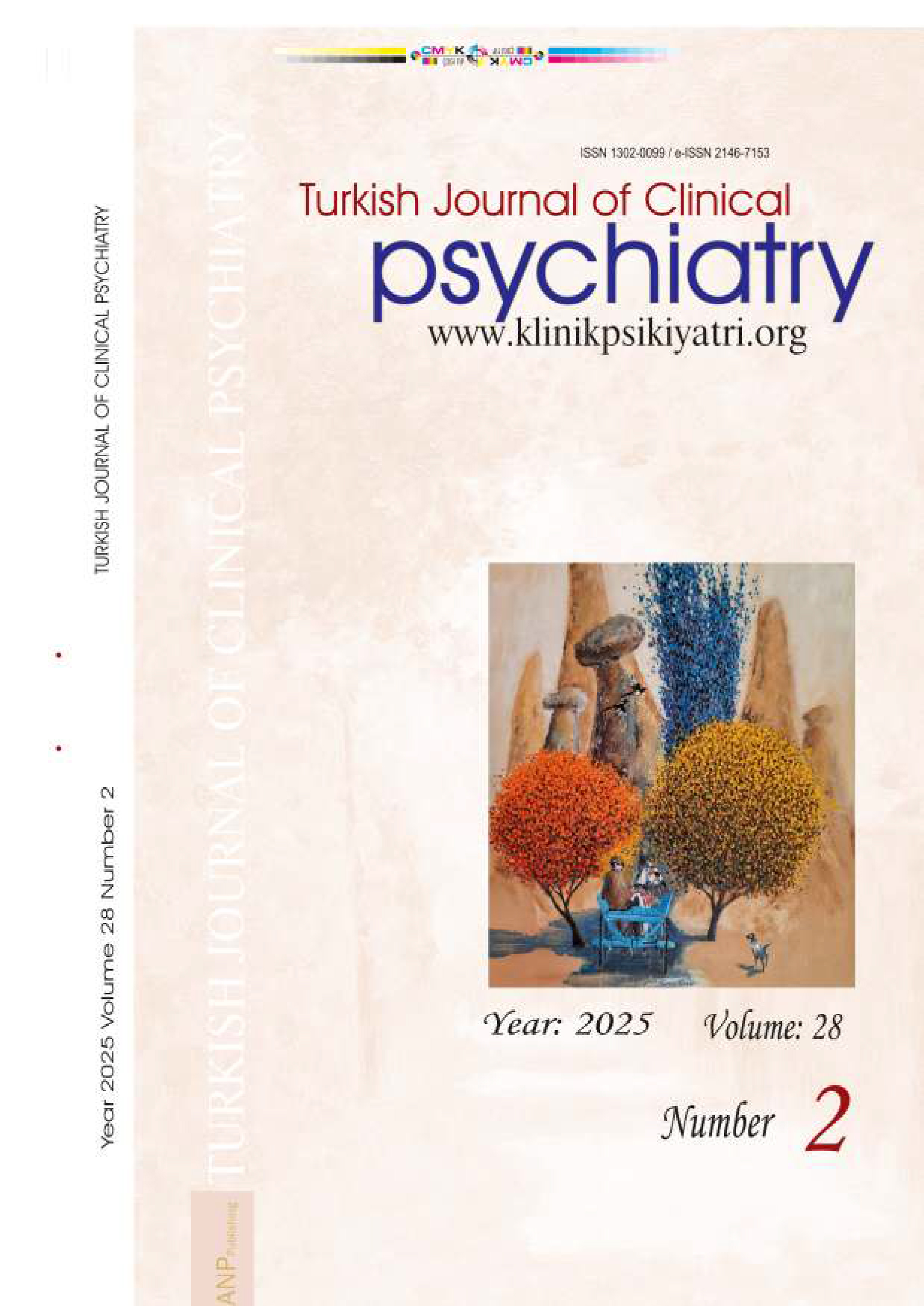





Volume: 27 Issue: 1 - 2024
| EDITORIAL | |
| 1. | Mental health action plan 2021-2023: What to say? What to do? Burhanettin Kaya doi: 10.5505/kpd.2024.69094 Pages 3 - 4 |
| RESEARCH ARTICLE | |
| 2. | A comparison for thyroid functions and clinical features in deficit and non-deficit schizophrenia Ali İnaltekin, Yasin Taşdelen doi: 10.5505/kpd.2024.22309 Pages 5 - 11 INTRODUCTION: The primary occurrence and persistence of negative symptoms observed in patients with schizophrenia is deficit syndrome. Although the association between thyroid hormones and schizophrenia symptoms has been reported, no studies have investigated thyroid function in patients with deficit schizophrenia (DS). This study aims to investigate the clinical features and thyroid function in DS patients by comparing them with patients with non-deficit schizophrenia (NDS) and a control group. METHODS: 33 subjects from DS, 35 subjects from NDS and 35 healthy control subjects were included in the study. Patients with schizophrenia were classified into DS and NDS using the deficit syndrome table. Thyroid function was assessed by the levels of TSH, free T3 (fT3), and free T4 (fT4). Sociodemographic data and clinical characteristics were evaluated using the Sociodemographic Data Form, the Positive Symptoms Evaluation Scale (SAPS), the Negative Symptoms Evaluation Scale (SANS), and the Calgary Depression in Schizophrenia Scale (CDSS). RESULTS: There was no significant difference between DS and NDS groups in terms of age, gender, marital status and education (p>0.05). The percentage of unemployed was significantly higher in the DS group than in the NDS group (p=0.005). There were 14 (42.4%) suicide attempts in the DS group and 11 (31.4%) in the NDS group, and there was no significant difference between the groups (p>0.05). There was no significant difference between the groups when comparing the thyroid functions of the DS, NDS and healthy control groups regarding fT4, fT3 and TSH (p>0.05). There was no significant correlation between TSH, free T3, free T4 and total SANS, total SAPS and CDSS scores (p>0.05). DISCUSSION AND CONCLUSION: According to our study thyroid function is not different in DS, NDS and healthy controls and is not associated with positive, negative and depressive symptoms in patients with schizophrenia. |
| 3. | The level of knowledge about autism spectrum disorders among a university hospital healthcare professionals in Turkey Hacer Gizem Gerçek, Çağla Çelikkol Sadıç, Aziz Kara doi: 10.5505/kpd.2024.86836 Pages 12 - 20 INTRODUCTION: Autism Spectrum Disorder (ASD) is a mental disorder with an increasing prevalence in recent years. In this study, the autism knowledge level of healthcare professionals from different occupational groups and the factors affecting the knowledge level were evaluated. METHODS: A total of three hundred and seventeen (317) healthcare professionals working in tertiary health institutions in Turkey were included in the study. Participants completed both the "Health Workers Information Form" and the "Knowledge about Childhood Autism Among Health Workers" (KCAHW) questionnaire. Knowledge about childhood autism (KCA) as measured by scores in the KCAHW questionnaire. RESULTS: The total mean score of participated healthcare professionals on KCAHW questionnaire was 12.62 ± 2.80. Physicians' KCAHW test scores were significantly higher than other healthcare professionals (p<0.001). KCA was significantly associated with the age of healthcare professionals, had a higher mean score with increasing age (r=0.139, p=0.013). As the education level of the healthcare professionals and the time spent in the profession increased, the KCA also increased (respectively, p=0.002, p=0.043). KCA of doctors who were residency students were statistically significantly lower than those of specialist doctors (p=0.008). KCA was found to be significantly higher in healthcare professionals who had training on autism (p=0.001) and those who worked with a child with autism (p=0.009). DISCUSSION AND CONCLUSION: In this study, it was found that healthcare professionals' knowledge about ASD is poor. Although physicians were more aware of the diagnostic criteria, their awareness of autism and its associated disorders was low, as were other healthcare professionals. Healthcare professionals should receive regular training. Specially, it should be targeted from physicians to residents and non-physician healthcare professionals. |
| 4. | The impacts of adult separation anxiety disorder on nomophobia Aslı Kazğan Kılıçaslan, Osman Kurt, Sevler Yildiz, Burcu Sırlıer Emir doi: 10.5505/kpd.2024.69862 Pages 21 - 29 INTRODUCTION: Based on the idea that there may be a link between smartphone addiction and adult separation anxiety disorder (ASAD), our aim was to examine the impacts of ASAD symptoms on nomophobia and whether they predict nomophobia among ASAD patients. METHODS: We randomly recruited 50 patients diagnosed with ASAD and 50 control subjects satisfying the inclusion criteria. We collected the data using a sociodemographic information form, the Adult Separation Anxiety Questionnaire (ASA-27), the Nomophobia Questionnaire (NMP-Q), the Beck Depression Inventory (BDI), and the Beck Anxiety Inventory (BAI). RESULTS: Fifty-four percent of the patients had moderate, and 46% showed mild nomophobia symptoms. The results revealed that, compared to healthy controls, the patients had significantly higher scores on the ASA-27, the BDI, the BAI, the NMP-Q (total), the NMP-Q not being able to access information, the NMP-Q giving up convenience, the NMP-Q not being able to communicate, and the NMP-Q losing connectedness (p=0.006 for the NMP-Q giving up convenience; p<0.001 for others). Moreover, the results yielded significant positive relationships between ASAD and the participants’ nomophobia total and subscale scores (except for losing connectedness) (p<0.05). Finally, ASAD scores significantly predicted nomophobia, not being able to access information, giving up convenience, and not being able to communicate. DISCUSSION AND CONCLUSION: To the best of our knowledge, our study is the first to report nomophobia levels among patients diagnosed with ASAD. The increased severity of separation anxiety symptoms contributed to the severity of nomophobia in the patients, which, in turn, significantly boosted the severity of their depression and anxiety. Moreover, the patients’ separation anxiety predicted their nomophobia, except for losing connectedness. Overall, our findings emphasize that smartphone use in ASAD patients should be minded. |
| 5. | Intimate partner violence and sexual dysfunction in women admitted to psychiatry outpatient clinic does culture affect outcomes? Burcu Kök Kendirlioğlu, Gozde Gundogdu Meydaneri doi: 10.5505/kpd.2024.39260 Pages 30 - 40 INTRODUCTION: Intimate partner violence (IPV) not only affects women's physical and mental health, but also affects their sexual health and causes various sexual dysfunctions. It was aimed to reveal the relationship between possible IPV and mental and sexual health in Turkish and Arabic women. METHODS: The study was designed as cross-sectional and observational. The study included 105 (50 Arabic and 55 Turkish) women between the ages of 18-50 years old. Domestic Violence Against Women Scale, Golombok- Rust Inventory of Sexual Satisfaction Scale, Beck Depression and Anxiety Inventory were applied. RESULTS: All women participating in the study were exposed to at least one of the subtypes of violence. A significant positive correlation was observed between Golombok-Rust total score and physical (p=0.003), emotional (p=0.006), verbal (p=0.027), sexual violence (p<0.001), and the total violence score (p=0.001). A significant positive correlation was observed between the total violence score and the infrequency (p=0.004), non-communication (p=0.024), avoidance (p=0.003), non-sensuality (p<0.001) scores. The scores of sexual communication, satisfaction, and anorgasmia were significantly higher and the score of sexual avoidance, touching, and vaginismus was significantly lower in the Arabic women than in the Turkish women. DISCUSSION AND CONCLUSION: IPV and cultural differences are related to sexual functions. The possibility of IPV exposure should be considered and questioned in women applying to psychiatric outpatient clinics, taking into account the effects of different cultures. |
| 6. | Evaluation of early maladaptive schemas and domains in social anxiety disorder specifiers and non-clinical samples Esengül Ekici, Şerif Bora Nazlı, Fatih Yığman doi: 10.5505/kpd.2024.08684 Pages 41 - 54 INTRODUCTION: Regarding symptoms, Social Anxiety Disorder (SAD) is a heterogeneous disorder, and DSM-5 defines it with a performance-only specifier. In this study, we aimed to examine early maladaptive schema, the differences in SAD specifiers with the non-clinical samples, and the prediction of early maladaptive schema domains on SAD specifiers’ symptom severity. METHODS: Our sample included 59 patients with performance only-SAD (P-SAD), 61 with unspecified SAD (U-SAD), and 155 individuals in non-clinical samples. We used the Young Schema Questionnaire-Short Form 3 and the Liebowitz Social Anxiety Scale to assess the samples. RESULTS: Our results were remarkable differences in early maladaptive schemas between individuals of SAD’s specifiers and non-clinical samples; we also found that although U-SAD’s social anxiety severity related to all early maladaptive schema domains, P-SAD’s social anxiety severity associated with Disconnection and Rejection and Impaired Autonomy & Performance schema domains. Our clinical findings suggest that the Disconnection and Rejection schema domain is positively, the Excessive Responsibility and Standards schema domain is negatively predicted for P-SAD’s social anxiety severity, and the Impaired Autonomy & Performance schema domain is positively predicted for U-SAD’s social anxiety severity. DISCUSSION AND CONCLUSION: Early maladaptive schema domains have essential impacts on social anxiety symptoms. Understanding the various early maladaptive schema differences among SAD specifiers and a non-clinical sample and predicting these specifiers’ social anxiety symptoms with early maladaptive schema domains might help explain different social anxiety disorders’ clinical symptomatology. |
| 7. | Comparison of substance users under judicial supervision with controls in terms of attention deficit hyperactivity disorder and emotion regulation difficulties Mustafa Akan, Nusret Ayaz, Kerim Uğur doi: 10.5505/kpd.2024.00878 Pages 55 - 64 INTRODUCTION: Substance abuse and addiction are reported to be approximately 2 times more common in individuals diagnosed with Attention Deficit Hyperactivity Disorder (ADHD) compared to the general population. Adults with ADHD have been stated to have difficulties in emotion regulation as well as core symptoms of the disease. In this study, it was aimed to evaluate individuals who applied to a university hospital psychiatry clinic probation clinic in terms of attention deficit hyperactivity disorder and emotion regulation difficulties. The hypothesis of the study is that individuals who apply to the outpatient clinic will have higher ADHD symptoms and emotion regulation difficulties than healthy controls. METHODS: The research was conducted between 18.06.22-30.10.22. 135 male patients diagnosed with substance use disorder and 141 healthy volunteers without any psychiatric disease were included in the study. Adult ADHD self-report scale (ASRS), Difficulty in Emotion Regulation Scale Short Form (DERS-16), and sociodemographic data form were administered to the participants. RESULTS: The probation group's ASRS total score, attention deficit and hyperactivity/impulsivity subscale scores were found to be statistically significantly higher than the control group (p=0.004, p=0.005, p=0.007, respectively). Also DERS-16 impulse and nonacceptance subscale scores of the probation group were statistically significantly higher than the control group (p=0.001, p=0.015, respectively). DISCUSSION AND CONCLUSION: ADHD and accompanying emotion regulation difficulties may increase the risk of substance use in adults. Considering these clinical features in individuals applying to the probation outpatient clinic may make therapeutic interventions more effective. |
| 8. | Examination of post-traumatic growth, post-traumatic stress symptoms, and neurocognitive flexibility levels in individuals who have experienced a traffic accident Cansu Aykaç, Nese Direk, Kerem Kemik, Tunç Alkın doi: 10.5505/kpd.2024.53189 Pages 65 - 73 INTRODUCTION: Pathological responses can occur in the aftermath of traumatic experiences, alongside positive changes in levels of functioning, such as Post-Traumatic Growth (PTG). Neurocognitive flexibility involves the adaptive restructuring of information in response to changing conditions. The aim of this study is to investigate the potential impact of neurocognitive flexibility on PTG. Post-Traumatic Stress Disorder (PTSD) and PTG are examined together. METHODS: A total of 96 volunteers of had a traffic accident, consisting of 43 individuals with a PTSD and 53 without a diagnosis of PTSD, participated in the study. Structured Clinical Interview for DSM-5, Clinician-Administered PTSD Scale, Sociodemographic and Trauma-Related Characteristics Data Form, Life Events Checklist for DSM-5, PTSD Checklist for DSM-5, Depression Anxiety Stress Scale 42, Post-Traumatic Growth Inventory, Stroop Test, Trail Making Test, and Category Fluency Test were used as assessment tools. RESULTS: According to correlation analyses, weak significant relationships were found between the PTG sub-dimension of changes in life philosophy and neurocognitive flexibility scores. Statistically significant relationships were found between PTSD and neurocognitive flexibility scores. However, no significant relationship was found between PTSD and PTG. Linear regression analyses revealed a trend between PTG and Category Fluency scores. DISCUSSION AND CONCLUSION: This study is the first in Turkey to examine the relationship between PTG and neurocognitive flexibility using neuropsychological tests. Including tests that measure neurocognitive flexibility in future studies with a larger sample size could yield more specific and robust findings. Investigating the impact of neurocognitive flexibility is theoretically important for understanding the cognitive variables that affect PTG and can help plan psychological interventions that encompass neurocognitive flexibility. This study was presented as a Poster Presentation at the 21st National Neuroscience Congress. |
| 9. | Investigation of the relationship between adult attention deficit hyperactivity disorder and reinforcement sensitivity in substance use disorders Esra Porgalı Zayman, Süheyla Ünal, Hatice Birgül Cumurcu, Özlem Özel Özcan, Rabia Bilici, Erşah Zayman doi: 10.5505/kpd.2024.56767 Pages 74 - 82 INTRODUCTION: It is known that adult ADHD comorbidity is high in cases with substance use disorder (SUD). With the prediction that the Behavioral Activation System (BAS) and the Behavioral Inhibition System (BIS), which Gray claims to underlie motivated behaviour, may be effective in these two psychopathological conditions, the relationship between BIS/BAS dimensions and ADHD symptoms in substance addicts was investigated in this study. METHODS: The study included 91 male patients over 18 who applied to the AMATEM outpatient clinic of Elazig Mental Health and Diseases Hospital for treatment and were diagnosed with substance use disorder according to DSM-5 and 99 healthy male controls with similar sociodemographic characteristics. A form in which sociodemographic and substance use-related questions were asked, and the Adult Attention Deficit Hyperactivity Disorder Self-Report Scale (ASRS), Wender-Utah Rating Scale (WURS), Behavioral Inhibition System / Behavioral Activation System Scale (BIS/BAS Scale) were given to the participants. RESULTS: In our study, adult ADHD prevalence was 10.1% among substance addicts. When the groups were compared according to the scores, a statistically significant difference was found between the individuals with substance use disorder and the control group regarding BIS-anxiety, FFFS-fear, WURS, and ASRS scores DISCUSSION AND CONCLUSION: Our findings suggest that an inhibitory system such as DKDS-fear may not be activated as negative feedback in substance addicts and may impulsively turn to substances to cope with increased anxiety. Substance use in individuals with ADHD may affect attention by increasing the sense of pleasure rather than hyperactivity or impulsivity. |
| REVIEW | |
| 10. | Clinical, genetic, and epigenetic markers associated with lithium response in bipolar disorder Bilge Targıtay Öztürk, Nese Direk doi: 10.5505/kpd.2024.55632 Pages 83 - 96 Bipolar disorder is a chronic and common psychiatric disease that causes poor quality of life and loss of functionality. Although lithium remains in the first place in the acute mania and maintenance treatment of bipolar disorder, its mechanism of action is still unclear. In addition, the response to lithium varies widely among patients. Up to 30-55% of patients with bipolar disorder do not benefit from lithium treatment or experience side effects that cause them to discontinue the treatment. As a result of the studies carried out to date, some clinical variables that predict the difference in lithium response among individuals have been identified, but consistent results have not been obtained. Difficulties in detecting lithium response over clinical variables, lack of consistent peripheral and neuroimaging markers, and familial clustering of the disease and treatment response led researchers to conduct genetic studies. Researchers have primarily focused on candidate gene studies. However, whole genome association studies have begun to be performed due to the inadequacy of candidate gene studies in detecting the lithium response, which is estimated to be polygenic. Data on lithium response and some single nucleotide polymorphisms, noncoding RNAs, and polygenic risk score associations were acquired from these studies. Recently, researchers have been working to elucidate the epigenetic mechanisms involved in gene-environment interaction. In this article, both clinical features and both prominent genetic and epigenetic markers associated with lithium response are reviewed and critical points that should be considered in future research are emphasized. |










